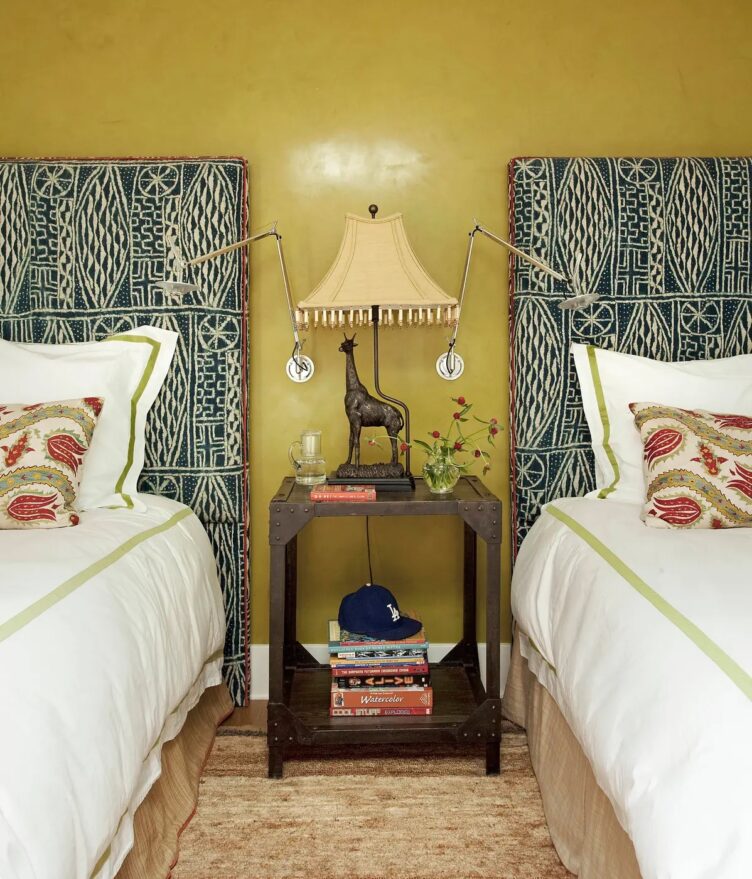Are you feeling in the dark about bedside lighting? When it comes to bedside lighting, the options are plentiful and go far beyond basic table lamps. So how do you know if lamps, sconces, floor lamps, or pendants are right for you? We’ve collected some illuminating tips from design experts to shed some light. Get their best advice for picking lighting that channels the right bedside manner.
RELATED READ: 6 Ways to Try Out Statement Lampshades

Determine Your Purpose
Before you start shopping for bedside lighting, consider your lighting’s function and your room’s aesthetic recommends the Chicago-based architecture and interior design firm, Searl Lamaster Howe. “Start by deciding if your bedside light will function for reading, ambiance, or decorative appeal,” says the firm. “If you’re looking for a reading light, for example, try sourcing lamps or sconces with adjustable arms or swiveling heads that allow you to direct the light where you need it.” If you’re primarily after a reading light, for instance, you’ll also want to ensure it provides adequate brightness. Have different goals in mind such as a lamp with a gentle glow that helps induce slumber? If so, consider a lamp with a thick shade and perhaps a dimmer.

Consider Size and Scale
Should the size of your bed affect your bedside lamp or sconce’s size? In a word, yes. “Pay attention to the size and scale of the bedside lighting fixture in relation to the furniture and space,” recommends Searl Lamaster Howe. Your nightstands’ sizes are perhaps the most important furniture pieces to take into account, but dressers, chairs, and beds are also worth taking into consideration. “If the furniture is visually heavy, opt for a lighter and more delicate lighting fixture, or vice versa,” says the firm. “Keep in mind that a large, bulky fixture can overwhelm the space, while a tiny one might go unnoticed.”

Pay Mind to the Wattage & Shade
You might not give too much thought to whether a living room lamp’s shade is opaque or gossamer, but in a bedroom, the right shade might be the difference between a peaceful slumber and a toss-and-turn scenario. Save the bright, direct light for rooms where the main event isn’t sleeping. In a bedroom, your best bet will be a lower-wattage bulb or a regular wattage paired with a shade that diffuses your lamp’s light. “A translucent or light-colored shade will provide a softer and more diffused light, while a darker shade will create a more focused and concentrated light,” says Searl Lamaster Howe. The firm also suggests installing dimmer switches or separate controls for each bedside light source so that depending on the time of day and personal preferences, each one can be adjusted to achieve its own mood and brightness levels.

Take Height into Account
“You want a bedside lamp to be tall enough so that the light is appropriate for reading, but the shade should also be large enough to cover the lightbulb from the vantage point of laying in the bed, otherwise it’s blinding,” says Allison Mattison of Massachusetts design firm Trellis Home Design. “Similarly, a lamp that is too short won’t offer enough light.” So what is the right height? The exact height of your lamp should be driven by the height of the headboard and nightstand, says Allison. “You want all of them to be appropriately scaled to one another,” she explains. With that in mind, don’t rule out the option to use floor lamps as bedside lighting. Especially in the event that you’re shopping for a bedside reading lamp, a floor lamp can offer a directed light overhead, perfect for reading.
Types of Lights to Consider

Tables Lamps
If you’re looking for a way to integrate color and texture into a bedroom, try a table lamp. Ceramic table lamps, especially, are a great canvas for color. They can also be extremely textural. Ceramic table lamps can showcase everything from luminous and smooth finishes to rough, incised finishes. When you throw metal, wood, and glass table lamp options into the mix, virtually anything is possible.

Sconces
Have nightstands with limited surface space? If so, sconces are a great option. Since sconces are affixed directly to the wall next to a bed, they don’t require a table to be pedestaled on. Beyond their space-saving qualities, sconces can be hung at whatever height you desire, making them less finicky than table lamps when it comes to height.

Pendants
Pendants aren’t often drafted for use as bedside lighting, but that’s exactly what makes them a compelling option. Whether you opt to hang one on either side of a nightstand or use one between two beds in a guest room or kids’ room, pendants visually draw the eye up, thanks to their stem which connects the pendant shade to the ceiling.

Floor Lamps
Love the look of sconces, but have windows on either side of your bed, or don’t want to hassle with professional installation? If so, consider floor lamps. Floor lamps’ shades will generally hover above a headboard, making their lighting effect similar to sconces. However, you don’t have to drill holes in the wall or hire an electrician to install them, making them the DIY decorator’s best friend.
Lead photo design by Haus of Meeshie / Photo by Aaron Snyder




















